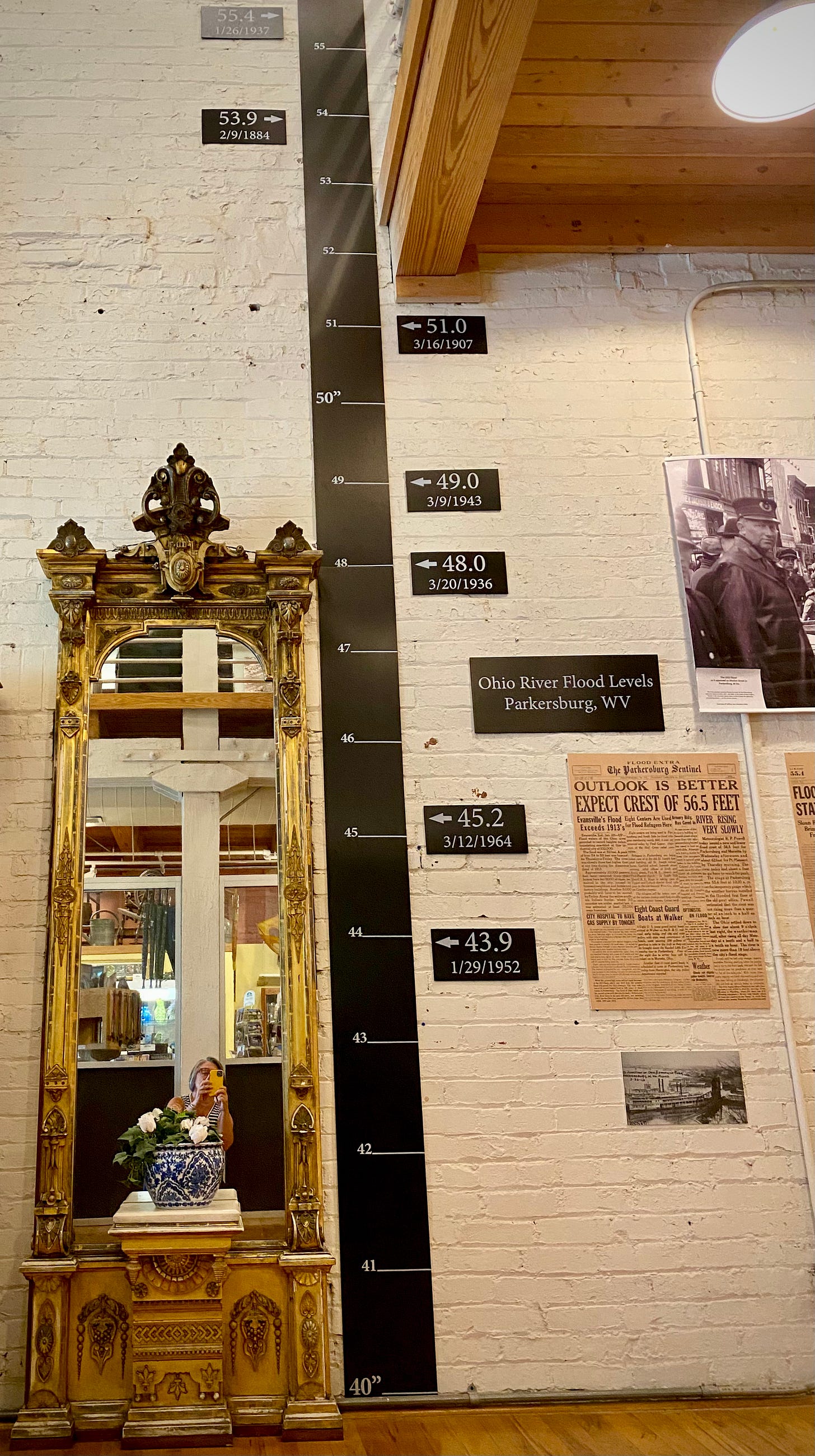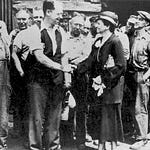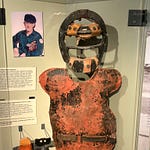This is Part One of “Flood to Food Banks,” a three-part exploration of how the Ohio River became America’s testing ground for social uplift.
With American hunger back in the national headlines, I’ve been thinking about how this story of hunger relief began. I was surprised to learn it wasn’t with pantries and food drives, but with the Ohio River’s most devastating flood at the start of Franklin Delano Roosevelt’s second term.
My own research on the topic started several years ago, when I visited the Blennerhassett Museum of Regional History in Parkersburg, West Virginia, during the summer of 2021. However, at the time, I wasn’t looking for the origins of the modern food bank system—I hadn’t even thought about it. It was just part of my general reconnaissance of the region and its many historical facets.
I bought an admission ticket and stepped into the first-floor gallery, where a black gauge climbs the white brick wall, ending past the landing of the second story balcony. It was like a ruler of reckoning showing flood levels from 1884, through 1964. If you look at the picture below, the scale begins at forty feet, because that’s the elevation of the museum floor above the river’s normal height. I tilted my head up, then back a little farther, squinting to see the highest line of its record crest: 55.4 feet, January 26, 1937.
The number is tidy, and the mark is exact, but the mind resists it without context, so here’s mine. At five-foot-one, I calculated it would take nearly eleven of me stacked head to toe to reach 55.4 feet. And yes, if you look closely in the mirror beside the gauge, you can see me in the reflection—small against a wall that once marked catastrophe.
Now, imagine the whole town underwater to understand what fifty-five feet really means in human terms.
What began here as an act of rescue in 1937—feeding, housing, and clothing the displaced—would teach government and charity alike how to manage hunger, and other human needs, long after the waters receded. It didn’t invent the modern food bank, but it changed how the nation understood feeding as logistics — a mindset federal agencies would soon build into national food programs.
Even before the river crested, the Red Cross was on the ground, issuing rations and setting up shelters in churches and schools. When the flood reached its peak, President Roosevelt declared a national emergency—one of the first in response to a natural disaster—and released ten million dollars for relief. In today’s dollars, we’re talking $220 – $250 million.
His order unlocked every corner of the New Deal: Works Progress Administration crews (WPA), Civilian Conservation Corps (CCC), the Army Corps of Engineers, and the Red Cross all moving in a single rhythm.
Harry Hopkins, Roosevelt’s trusted advisor and briefly his Secretary of Commerce, oversaw the WPA’s seven divisions, from heavy construction to public service, education, and the women’s sewing and nursing projects that reached into every county. The WPA had begun as a jobs program employing more than 8.5 million people for an average monthly salary of about $41. Under Hopkins, the seven divisions moved as one—not only repairing infrastructure, but also delivering food, sewing blankets, and keeping disease at bay.1
Within a week of the crest, field kitchens were serving thousands of meals a day—a wartime scale of feeding in a peacetime disaster. The flood proved that compassion, when well organized, could act on a scale it had never attempted in peacetime.
Back at my tour of the Blennerhassat Museum, I walked into another exhibit hall featuring a wooden skiff resting beneath a photograph of a long-ago packet boat. It’s small, flat-bottomed, and open to the air—the kind of boat that Parkersburg’s police and firemen rowed to deliver food and evacuate families, scraping across flooded porches and telephone wires along the way. For weeks, the city was an archipelago of rooftops and rescue routes, as were sister cities for all 981 miles of the river.

But police and fire crews weren’t the only ones rowing skiffs. Younger men from the Civilian Conservation Corps were pulled from their usual duties—planting trees, building bridges, and breaking the ground—literally—on the Blue Ridge Parkway.
My grandfather was a “CC man,” as they called themselves, but wasn’t serving at the time of the flood. Had he been, he would have rowed a skiff through flooded streets, delivering food and medicine, and disinfecting the mud with lime and kerosene to prevent disease—plus anything else the relief effort required of him.
So yes, before America could build a system to feed its hungry, it had to learn how to feed its stranded. The Ohio River flood didn’t just reshape levees and zoning maps—it rewired the nation’s sense of how care could be organized.
By the spring of 1937, the Ohio was back in its banks, but the idea it unleashed kept flowing east. Relief workers and engineers carried their notebooks to Pittsburgh, where federal and local leaders began asking a new question: could the same system that fed the stranded be adapted to feed the poor?
That experiment—the Pittsburgh “trial project”—is where this story turns next week, and yes it will include trivia.
This essay is part of “Flood to Food Banks,” a three-part exploration of how the Ohio River corridor shaped America’s approach to organized care.
Here’s a documentary about the 1937 Flood, filmed in 1980, so it’s not Ken Burns-quality production values. But that doesn’t matter. Its focus is Evansville, Indiana and the Tri-State, with a panel of people who lived through it. Great stuff.

The WPA program in the arts led to the creation of the National Foundation for the Arts and the National Endowment for the Humanities.











